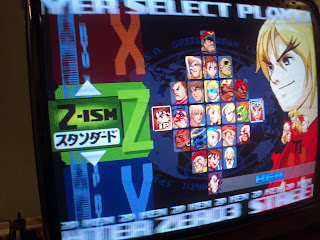I already wrote about the astro lot that I got recently. Part of the lot was 6 tubes and chassis. When I got the parts tested only 1 of the 6 chassis was working. I had another MS9 chassis that I got a while ago as well, so I had 6 non-working chassis to repair, 3 MS8 and 3MS9. I hooked em all up to my test tube and wrote down some notes as to what was going down with them (e.g. no vert deflection, no h sync, unstable width, etc.).
Last Friday I decided to actually start debugging one. It is an MS9 by Nanao. This one I've actually had for a while. I bought it on eBay as a non-working chassis for about $70. I figured I would be able to either fix it or scrap it for parts.
When I hooked it up at first it looked like this:
The image was all washed out and wobbly. Something was obviously not right. Those jailbars were actually from the cps2 A and B boards not being completely seated correctly, but the other artifacts were from the bad chassis. Based on what I saw on screen I determined this was probably going to be the easiest of my chassis to fix, so that's why I started with this one. I knew certain things were working, like B+ power, flyback transformer, horizontal and vertical deflection, etc. There would be no raster if these things weren't functioning. The picture looking washed out and wobbly is not as bad as you'd think. I determined that most of the problems stemmed from old dried out caps so I decided to do a partial cap-kit and then reevaluate the thing.
When I pulled out the monitor chassis and put it on my bench I noticed there were at least 2 different types of caps on the chassis. The original brown ones were there in the B+ area, however most of the caps in the vertical deflection circuit and the sync circuit were replaced with some other black caps. To me this said that someone had already done a repair on this chassis or attempted a repair. I decided to check the values of the newer black caps, but not change them. I used a cap list for the MS9 chassis and just went down them one by one, changing out any that were the older, original caps. Eventually I got down about 2/3 of the way through the cap list and saw one that was suspect!??!?!
Great color, clarity, and stability! After a quick tuning of the chassis pots and remote board I was in business. I was really pleased at this point, knowing that this chassis was repaired. I knew it would be easy, but I didn't think it would be that easy. One thing that made the whole process much easier was the use of liquid flux. I have never used it before and always just brute forced joints... After seeing how well it worked I couldn't imagine doing repairs again without it. For some things it doesn't matter how hot you get the pcb... but if you're trying to repair something without making it worse or less reliable... you need to be really conscious about how much heat you're putting into it. When you use flux, the heavily oxidized joints on these old boards are much more cooperative.
Here's a picture of the whole thing running on my test bench. I want to reorganize the whole thing a bit, but it's good enough to do some quick testing with.
And here's a pic of the MS9 after being fully repaired. Notice how there's at least 3 different brands of caps on this board! I'm glad this one only took one evening of debugging.
If the other chassis are as cooperative, I'll be really happy. I think the next one I am going to debug is the MS8 with vertical collapse. Time to order some LA7832 ICs and more cap kits! Stay tuned for an update on the other chassis as I get to them. Also, it looks like I might be picking up a pair of Aero City cabs with bad chassis in them... Hopefully I can get them repaired as well. I'll blog about that restoration if it turns out ok.














